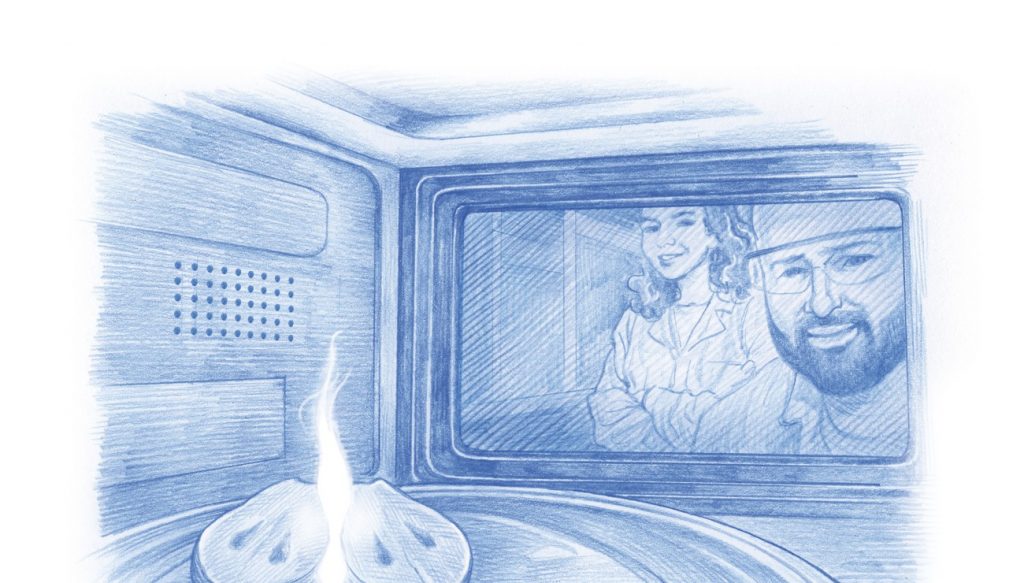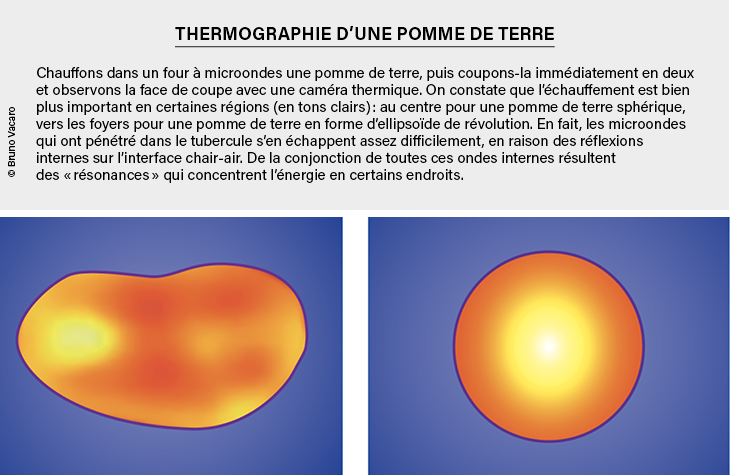
flambee raisins in the microwave | for information
One popular experiment on YouTube involves placing grape halves in a microwave oven, the two hemispheres still attached to a small piece of skin, which is preserved while slicing. When the oven is lit, flames appear between the two halves. What is the reason for this?
Most interpretations claim that the grape hemispheres act like antennas and that the intense electric current circulating in the skin would be at the origin of the plasma, the hot and ionized gaseous medium formed between the two parts of the fruit. Recent experiments by three physicists in Canada (see references), It turns out that this is not so: the plasma is caused by the presence of a strong electromagnetic field at the point of contact between the two halves of the grain, which vaporizes the substance and ionizes the sodium and potassium atoms contained in the grape flesh.
Inhomogeneous heating
To better understand this phenomenon, let’s start with the following experiment. We put the beautiful raw potatoes in the microwave for about twenty seconds. These potatoes are then cut in half and the internal temperature is observed with a thermal camera. what do we see? Heating is very heterogeneous, the two hottest places are located in the core of the potato and are separated by about 2 cm. Since the heating of the meat is caused by microwave absorption, it is proportional to the electromagnetic field strength in the studied location: this means that the microwave field presents the same intensity inhomogeneity as the temperature.

© Bruno Vaccaro, from the infrared image of Jean-Michel Corti
Why is the field so heterogeneous inside a potato? Could this be due to the standing wave formed by the electromagnetic field in the oven which has the effect of heating food differently depending on where it is located? The answer is no, for several reasons.
First, the potato is placed on a rotating disk and thus moves through the nodes (micro) and bellies (maximum) of the standing wave in the microwave field. So it undergoes uniform heating on average.
Then, the separation of the two tunings is on the order of half the wavelength of the microwave field, that is, 6.5 cm (the frequency of microwaves is 2.45 GHz); It is much more than 2 cm that separates the maximum observed temperature.
Finally, microwaves are gradually absorbed by food penetration: the intensity decreases by about two-thirds for every centimeter crossed in fruits and vegetables. Should we not observe maximum heating not in the core but at the surface, where the field has not yet been softened by absorption?
inner reflections
So we must look for another explanation. If we assimilate the potato into an ellipsoid of revolution, it seems that the field has been concentrated in the foci of this ellipsoid. This indicates that the microwaves broke badly when entering the potatoes. To see if this is indeed the case, we must be interested in the “optical indicator” of potato meat, that is, in the relationship between the speed of light in a vacuum and its speed in the tuber.
Potatoes are mainly composed of water: however, at 2.45 GHz, the water index is large and equal to 8.9 (comparable to 1.5, the glass index of visible light). As a result, the refraction of microwaves is already strong when crossing the air-potato interface, and once inside the tuber, it is difficult for it to get out. Thus, inside a potato, any wave that reaches the interface with a fall greater than 6.5° (with respect to the perpendicular to the interface) will undergo a total reflection. Even at low incidents, a large part of the wave is reflected (in perpendicular incident to the interface approximately 63% of the energy is reflected).
This means that the wave that penetrated the potato and propagated there can be reflected many times at the air interface. Of course, it will be attenuated by absorption and airborne parts in low states, but nevertheless it remains partially trapped: the potato therefore forms in relation to the electromagnetic field a kind of cavity where the latter can form a standing wave. Even if this cavity has a high attenuation rate, it can show resonance, that is, the wave modes present the observed maximum and minimum, which the thermal camera can visualize due to the accompanying heating.
Well-focused area
To ensure these ideas, one can perform the experiment in a more controlled manner using a bead of sodium polyacrylate (a superabsorbent substance) inflated with water, the advantage is that one can choose the diameter of the sphere and calculate the density entirely from the inside and outside of the electromagnetic field.
After heating the ball in the microwave and then cutting it in half, there is a hot spot in the middle. This confirms that the microwave field not only passes through the bead, but is concentrated there. The marble, whatever its size, is the site of “Echo Mi”, named after the German physicist Gustav Mie who, at the beginning of xxNS century, he studied in detail the resonances within the spheres. Calculations show that the maximum of this resonance is located in the center of the sphere. In addition, they recall the presence of a “ephemeral wave” in the air, outside the sphere: it is an insignificant amplitude field overflowing from the body, which one cannot detect by warming up, but plays a decisive role in the sequel.
Now let’s think of two identical balls that we gradually add together. When the difference between them is greater than their diameter, the sphere structure in both spheres remains unchanged or almost unchanged. On the outside, however, the ephemeral wave tightens on the axis connecting the two spheres. At shorter distances, the field structure ends up with a profound change: when the two spheres get very close (0.5 millimeters to 16 millimeters in diameter), most of the energy is seen concentrated in the space between the spheres and no longer in their centers, which is very surprising!

© From H. K. Khattak, P. Bianucci and A. D. Slepkov, PNAS, vol. 116 (10), p. 4000-4005, 2019
A typical measure of intensity change in standing waves composed of traveling waves is generally on the order of the wavelength of radiation. This is what we observed inside the potatoes. On the other hand, in the world of ephemeral waves, there is no limit: energy can be concentrated in regions of a size much smaller than the wavelength.
With creatine getting so close, we have a great example. The thickness of the region in which the field is confined is a hundred times smaller than the wavelength of the latter, and its diameter is about twenty times smaller. The intensity of the electromagnetic field at this location would then be so high that the material present would be heated until it evaporated. In the case of the experiment with grapes, the spectrum of light emitted indicates that the sodium and potassium atoms in the grape flesh are ionized and make up the famous plasma.

“Organizer. Social media geek. General communicator. Bacon scholar. Proud pop culture trailblazer.”
